
| Mythology |
|---|
A pantheon is the particular set of all gods of any individual polytheistic religion, mythology, or tradition. [1]

| Mythology |
|---|
A pantheon is the particular set of all gods of any individual polytheistic religion, mythology, or tradition. [1]
The word, pantheon, derives from Greek πάνθεον pantheon, literally "(a temple) of all gods", "of or common to all gods" from πᾶν pan- "all" and θεός theos "god".
Some well-known historical polytheistic pantheons include the Sumerian gods and the Egyptian gods, and the classical-attested pantheon which includes the ancient Greek religion and Roman religion.[ citation needed ] Post-classical polytheistic religions include Norse Æsir and Vanir, the Yoruba Orisha, the Aztec gods, and many others.
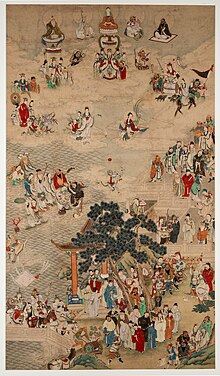
A pantheon of gods is a common element of polytheistic societies. A society's pantheon can be considered an aspiring self-reflection of that society:
A pantheon is an overview of a given culture's gods and goddesses and reflects not only the society's values but also its sense of itself. A pantheon directed by a thunderbolt wielding autocrat might suggest a patriarchy and the valuing of warrior skills. A pantheon headed by a great-mother goddess could suggest a village-based agricultural society. To confront the pantheon of the Egyptians is to confront a worldview marked by a sense of death and resurrection and the agricultural importance of the cycles of nature. The Greek pantheon is a metaphor for a pragmatic view of life that values art, beauty, and the power of the individual, and that is somewhat skeptical about human nature. [2]
In the modern vernacular, most historical polytheistic religions are referred to as "mythology". [3]
Scholars such as Jaan Puhvel, J. P. Mallory, and Douglas Q. Adams have reconstructed aspects of the ancient Proto-Indo-European religion, from which the religions of the various Indo-European peoples derive, and that this religion was an essentially naturalist numenistic religion.[ citation needed ] An example of a religious notion from this shared past is the concept of *dyēus , which is attested in several distinct religious systems.[ citation needed ]
In many civilizations, pantheons tended to grow over time.[ citation needed ] Deities first worshipped as the patrons of cities or places came to be collected together as empires extended over larger territories. Conquests could lead to the subordination of the elder culture's pantheon to a newer one, as in the Greek Titanomachy, and possibly also the case of the Æsir and Vanir in the Norse mythos.[ citation needed ] Cultural exchange could lead to "the same" deity being renowned in two places under different names, as seen with the Greeks, Etruscans, and Romans, and also to the cultural transmission of elements of an extraneous religion into a local cult, as with worship of the ancient Egyptian deity Osiris, which was later followed in ancient Greece. Max Weber's 1922 opus Economy and Society discusses a tendency of the ancient Greek philosophers to interpret gods worshiped in the pantheons of other cultures as "equivalent to and so identical with the deities of the moderately organized Greek pantheon". [4]
In other instances, however, national pantheons were consolidated or simplified into fewer gods, or into a single god with power over all of the areas originally assigned to a pantheon.[ citation needed ] For example, in the ancient Near East during the first millennium BCE, Syrian and Palestinian tribes worshiped much smaller pantheons than had been developed in Egypt and Mesopotamia. [5] Weber also identified the link between a pantheon of gods and the development of monotheism, proposing that the domination of a pantheon by a particular god within that pantheon was a step towards followers of the pantheon seeing that god as "an international or universal deity, a transnational god of the entire world". [4] The first known instance of a pantheon being consolidated into a single god, or discarded in favor of a single god, was with the development of the short-lived practice of Atenism in ancient Egypt, with that role being accorded to the sun god. [6] A similar process is thought to have taken place with respect to the Israelite deity Yahweh, who, "as a typical West Semitic deity... would have four or five compatriot gods in attendance as he became the national high god". [5]
The concept of a pantheon of gods has been widely imitated in Twentieth-century fantasy literature and role-playing games like Dungeons & Dragons . These uses tend to borrow heavily from historical patterns. In these contexts, it is considered important for the writer to construct a pantheon of gods that fits the genre, where the characteristics of the gods are in balance so that none of them is able to overwhelm the story, and so that the actions of the characters are not overwhelmed by the machinations of the gods. [7]

In order to avoid the difficulty of giving an exhaustive list of deities when devoting a temple or sacred building, a structure explicitly dedicated to "all deities" also came to be referred to as a "Pantheon". [8] The best known of such structures is the Pantheon of Rome, first built by Marcus Agrippa as part of a complex created by him on his own property in the Campus Martius in 29–19 BCE. [9] The building standing today was constructed on the same site around 126 CE. It was dedicated to "all gods" as a gesture embracing the religious syncretism in the increasingly multicultural Roman Empire, with subjects worshipping gods from many cultures and traditions. The building was later renovated for use as a Christian church in 609 under Pope Boniface IV. [10]
[T]he relation between the building and the primary reference point of the term 'pantheon', the pantheon of the gods, has always been a matter of the greatest uncertainty. By the sixteenth century these two aspects, the building and the grouping of gods, had become merged, to the extent that the building in Rome became the principal model for subsequent 'pantheons'. [8]
Since the 16th century, "pantheon" has also been used in a secular sense to refer to the set of a society's exalted persons—initially including heroic figures, and later extending to celebrities, generally. [11] Lord Byron drew this connection after viewing the busts of famous historical figures in the Roman Pantheon, writing in Childe Harold's Pilgrimage of how he wished to be at the center of an English Pantheon, and thereby associated with divinity. [12] The Pantheon "thus imbues the modern with the aura of the divine", and "models the interplay of ancient and modern forms of fame". [12] This trend continued into modern times, with the word "pantheon" 'of or for the gods' being reflected in the journalistic meme that refers to financial titans as "Masters of the Universe". For example: Francis Ford Coppola has been described as a member of "that revered pantheon of independent movie directors, which broke the standard Hollywood studio mold as the 1960s expired". [13]
Ancient Egyptian religion was a complex system of polytheistic beliefs and rituals that formed an integral part of ancient Egyptian culture. It centered on the Egyptians' interactions with many deities believed to be present and in control of the world. About 1,500 deities are known. Rituals such as prayer and offerings were provided to the gods to gain their favor. Formal religious practice centered on the pharaohs, the rulers of Egypt, believed to possess divine powers by virtue of their positions. They acted as intermediaries between their people and the gods, and were obligated to sustain the gods through rituals and offerings so that they could maintain Ma'at, the order of the cosmos, and repel Isfet, which was chaos. The state dedicated enormous resources to religious rituals and to the construction of temples.
Henotheism is the worship of a single, supreme god that does not deny the existence or possible existence of other deities that may be worshipped. Friedrich Schelling (1775–1854) coined the word, and Friedrich Welcker (1784–1868) used it to depict primitive monotheism among ancient Greeks.
Monotheism is the belief that one god is the only deity. A distinction may be made between exclusive monotheism, in which the one God is a singular existence, and both inclusive and pluriform monotheism, in which multiple gods or godly forms are recognized, but each are postulated as extensions of the same God.
Theism is broadly defined as the belief in the existence of at least one deity. In common parlance, or when contrasted with deism, the term often describes the philosophical conception of God that is found in classical theism—or the conception found in monotheism—or gods found in polytheistic religions—or a belief in God or gods without the rejection of revelation, as is characteristic of deism.

Yahweh was an ancient Levantine deity, the national god of the Israelite kingdoms of Israel and Judah, and later the god of Judaism and its other descendant Abrahamic religions. Though no consensus exists regarding the deity's origins, scholars generally contend that Yahweh is associated with Seir, Edom, Paran and Teman, and later with Canaan. The origins of his worship reach at least to the early Iron Age, and likely to the Late Bronze Age, if not somewhat earlier.
Monolatry is the belief in the existence of many gods, but with the consistent worship of only one deity. The term monolatry was perhaps first used by Julius Wellhausen.
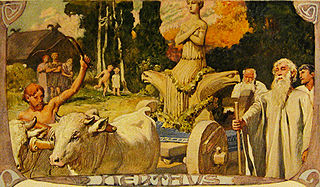
Germanic mythology consists of the body of myths native to the Germanic peoples, including Norse mythology, Anglo-Saxon mythology, and Continental Germanic mythology. It was a key element of Germanic paganism.
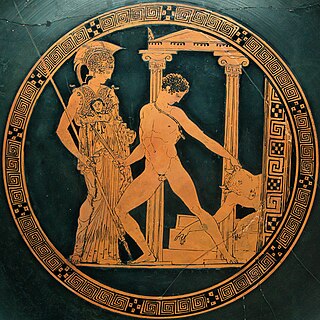
In ancient Greek religion and mythology, the twelve Olympians are the major deities of the Greek pantheon, commonly considered to be Zeus, Poseidon, Hera, Demeter, Aphrodite, Athena, Artemis, Apollo, Ares, Hephaestus, Hermes, and either Hestia or Dionysus. They were called Olympians because, according to tradition, they resided on Mount Olympus.
Idolatry in Judaism is prohibited. Judaism holds that idolatry is not limited to the worship of an idol itself, but also worship involving any artistic representations of God. The prohibition is epitomized by the first two "words" of the decalogue: I am the Lord thy God, Thou shalt have no other gods before me, and Thou shalt not make unto thee any graven image or any image in the sky, on earth or in the sea. These prohibitions are re-emphasized repeatedly by the later prophets, suggesting the ongoing appeal of Canaanite religion and syncretic assimilation to the ancient Israelites.
A supreme deity, supreme god or supreme being is the conception of the sole deity of monotheistic religions or, in polytheistic or henotheistic religions, the paramount deity or supernatural entity which is above all others.

Interpretatio graeca, or "interpretation by means of Greek [models]", refers to the tendency of the ancient Greeks to identify foreign deities with their own gods. It is a discourse used to interpret or attempt to understand the mythology and religion of other cultures; a comparative methodology using ancient Greek religious concepts and practices, deities, and myths, equivalencies, and shared characteristics.
Ancient Semitic religion encompasses the polytheistic religions of the Semitic peoples from the ancient Near East and Northeast Africa. Since the term Semitic itself represents a rough category when referring to cultures, as opposed to languages, the definitive bounds of the term "ancient Semitic religion" are only approximate, but exclude the religions of "non-Semitic" speakers of the region such as Egyptians, Elamites, Hittites, Hurrians, Mitanni, Urartians, Luwians, Minoans, Greeks, Phrygians, Lydians, Persians, Medes, Philistines and Parthians.

Canaanite religion was a group of ancient Semitic religions practiced by the Canaanites living in the ancient Levant from at least the early Bronze Age to the first centuries CE. Canaanite religion was polytheistic and in some cases monolatristic. It was influenced by neighboring cultures, particularly ancient Egyptian and Mesopotamian religious practices. The pantheon was headed by the god El and his consort Asherah, with other significant deities including Baal, Anat, Astarte, and Mot.

Kemetism, or Kemetic paganism, is a neopagan religion and revival of the ancient Egyptian religion, emerging during the 1970s. A Kemetic or Kemetic pagan is one who follows Kemetism.

As polytheistic systems evolve, there is a tendency for one deity to achieve preeminence as king of the gods. This tendency can parallel the growth of hierarchical systems of political power in which a monarch eventually comes to assume ultimate authority for human affairs. Other gods come to serve in a Divine Council or pantheon; such subsidiary courtier-deities are usually linked by family ties from the union of a single husband or wife, or else from an androgynous divinity who is responsible for the creation.
The traditional Berber religion is the sum of ancient and native set of beliefs and deities adhered to by the Berbers. Many ancient Berber beliefs were developed locally including the cults for local gods such as Atlas, and the goddess Tanit and Ammon, whereas others were influenced over time through contact with others like ancient Egyptian religion such as Isis which was worshipped in eastern Libya, or borrowed during antiquity from the Punic religion such as Eshmun and Baal, Judaism, Iberian mythology, and the Hellenistic religion like the worship of Apollo and Ceres. Some of the ancient Berber beliefs still exist today subtly within the Berber popular culture and tradition. Syncretic influences from the traditional Berber religion can also be found in many other faiths around the Mediterranean.
The term Urmonotheismus or "primitive monotheism" expresses the hypothesis of a monotheistic Urreligion, from which polytheistic religions allegedly degenerated. This evolutionary view of religious development contrasts diametrically with another evolutionary view on the development of religious thought: the hypothesis that religion progressed from simple forms to complex: first pre-animism, then animism, totemism, polytheism, and finally monotheism.
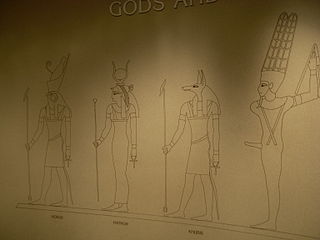
Polytheism is the belief in or worship of more than one god. According to Oxford Reference, it is not easy to count gods, and so not always obvious whether an apparently polytheistic religion, such as Chinese Folk Religions, is really so, or whether the apparent different objects of worship are to be thought of as manifestations of a singular divinity. Polytheistic belief is usually assembled into a pantheon of gods and goddesses, along with their own religious sects and rituals. Polytheism is a type of theism. Within theism, it contrasts with monotheism, the belief in a singular God who is, in most cases, transcendent.

A deity or god is a supernatural being considered to be sacred and worthy of worship due to having authority over the universe, nature or human life. The Oxford Dictionary of English defines deity as a god or goddess, or anything revered as divine. C. Scott Littleton defines a deity as "a being with powers greater than those of ordinary humans, but who interacts with humans, positively or negatively, in ways that carry humans to new levels of consciousness, beyond the grounded preoccupations of ordinary life".
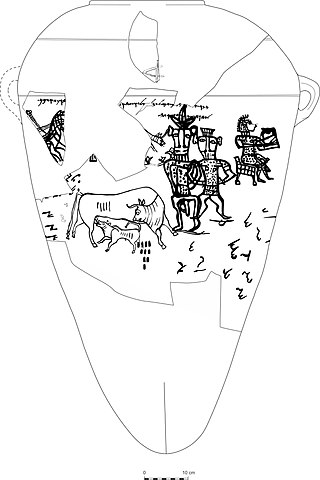
Yahwism, as it is called by modern scholars, was the religion of ancient Israel and Judah. An ancient Semitic religion of the Iron Age, Yahwism was essentially polytheistic and had a pantheon, with various gods and goddesses being worshipped by the Israelites. At the head of this pantheon was Yahweh, held in an especially high regard as the two Israelite kingdoms' national god. Some scholars hold that the goddess Asherah was worshipped as Yahweh's consort, though other scholars disagree. Following this duo were second-tier gods and goddesses, such as Baal, Shamash, Yarikh, Mot, and Astarte, each of whom had their own priests and prophets and numbered royalty among their devotees.